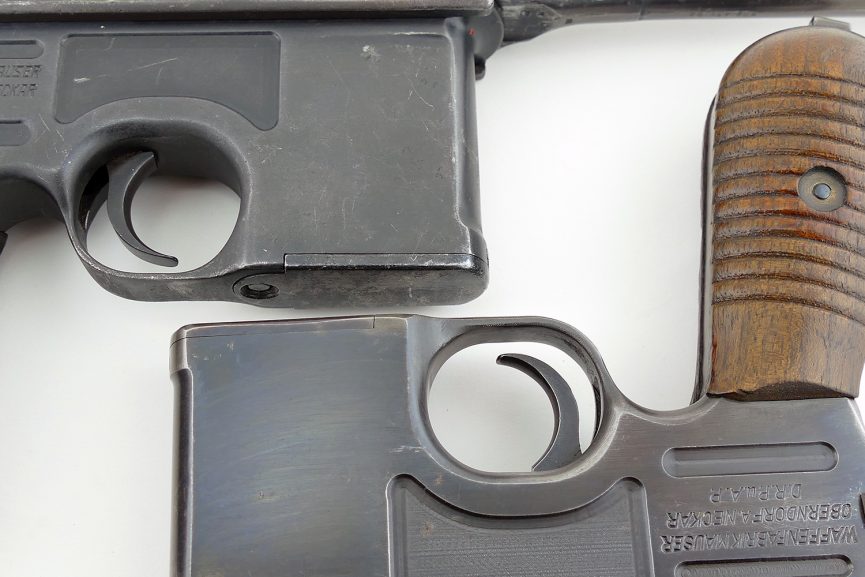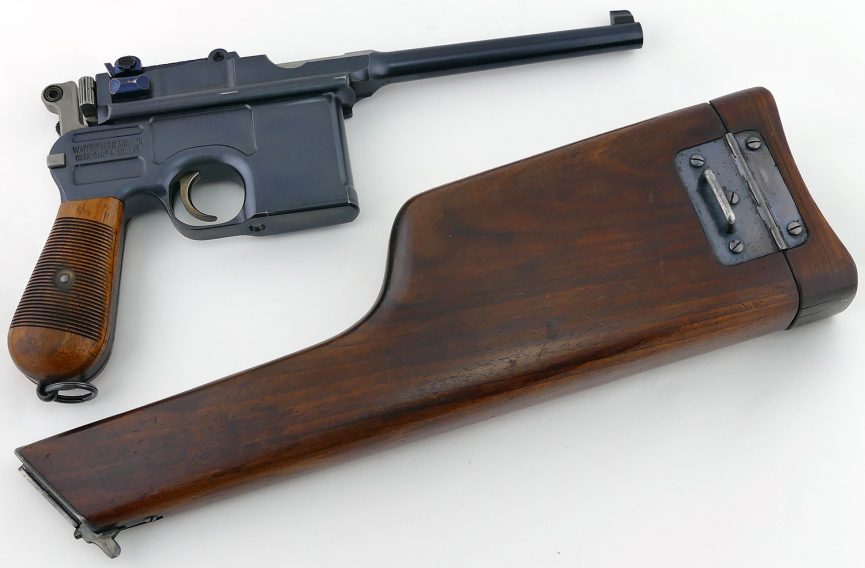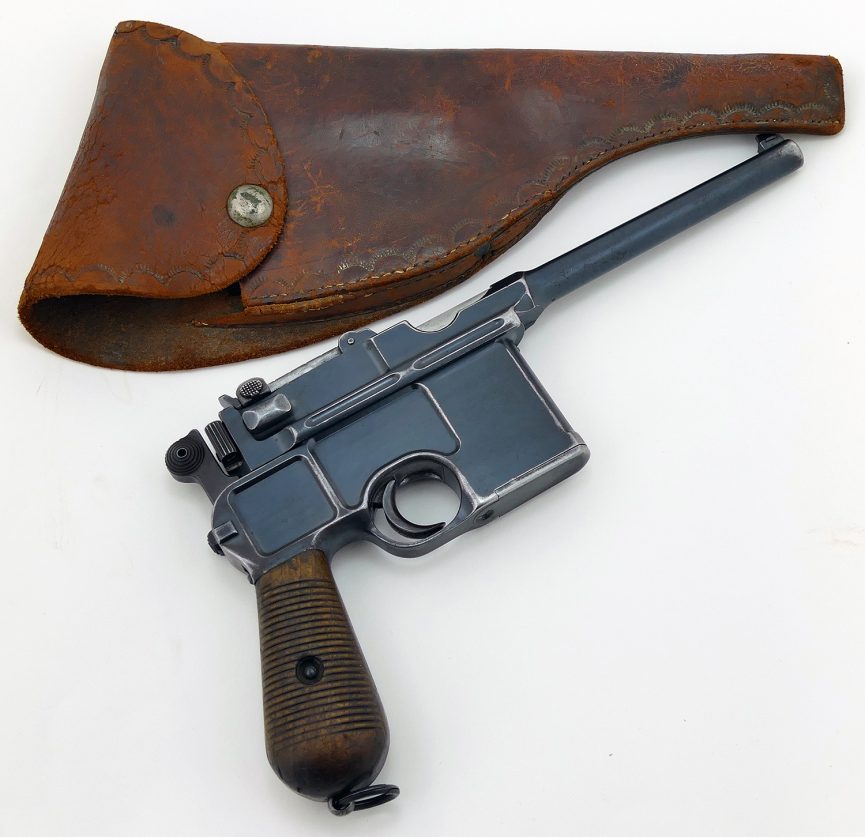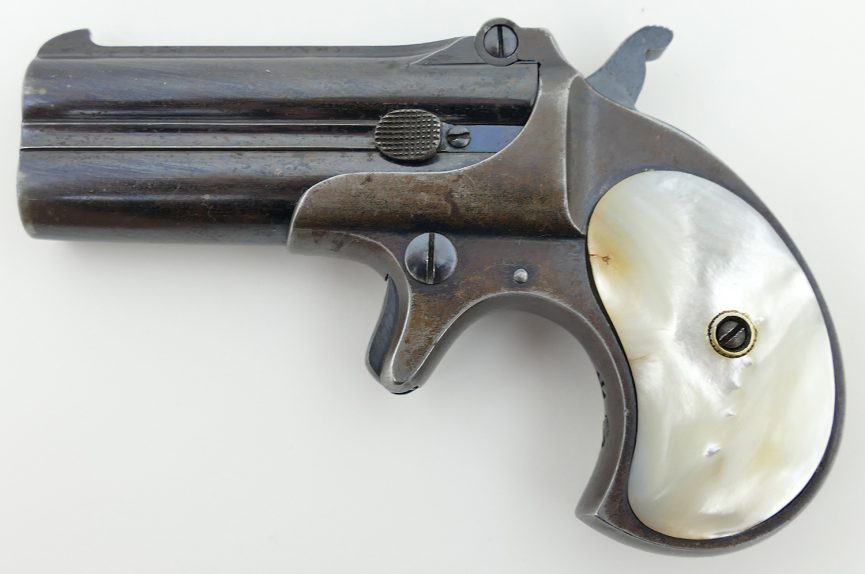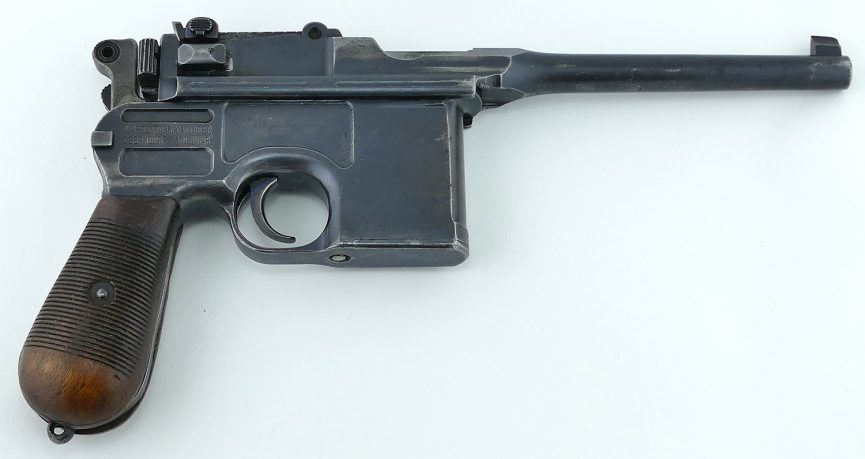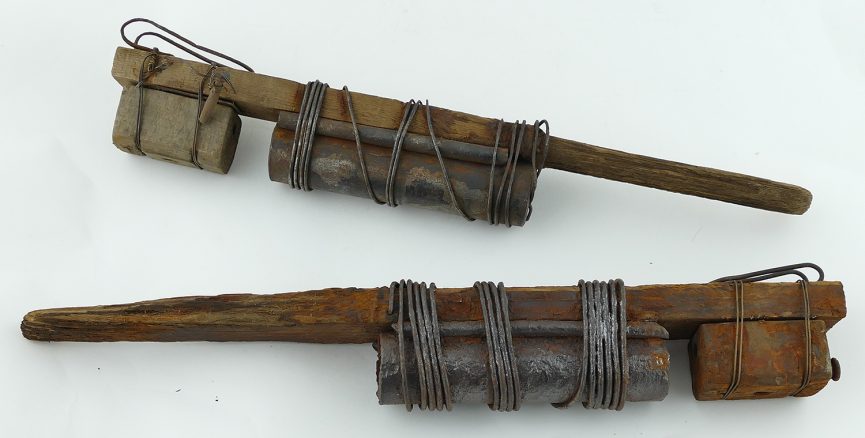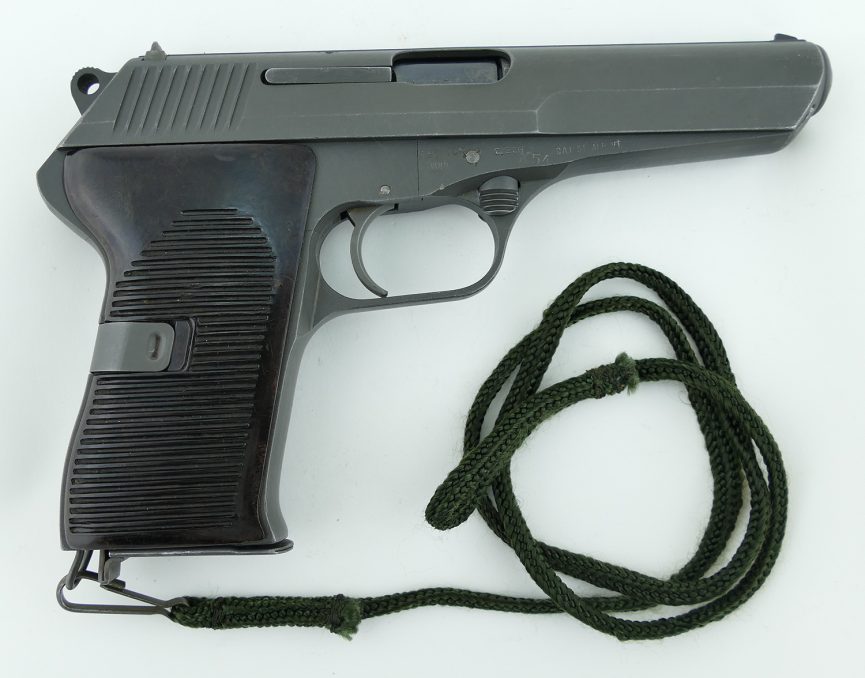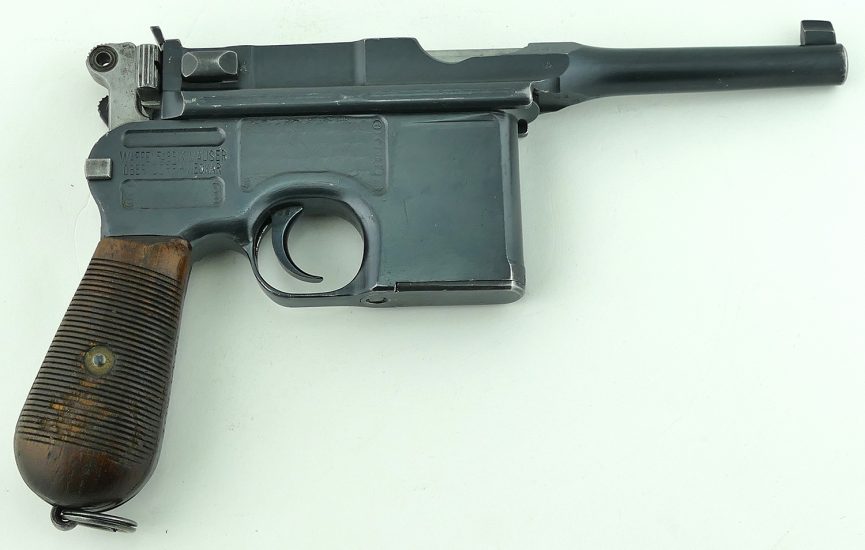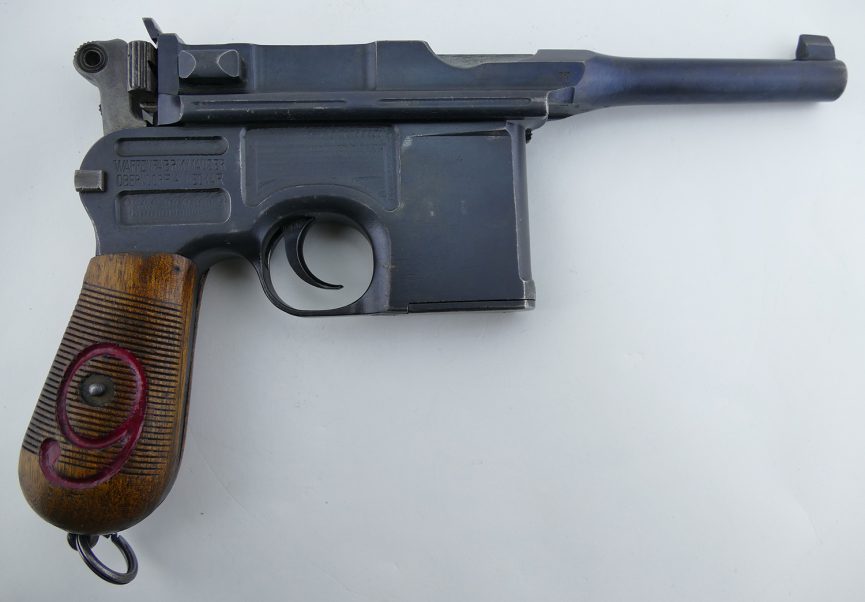Identifying a Refinished or Reblued Mauser C/96 Broomhandle The Mauser C/96 Broomhandle pistol was manufactured between 1896 until about 1936, and over a million examples were made. In the subsequent years, a myriad of fates befell these pistols. A small handful survive in essentially new condition, while others have seen long years of hard service and barely function. Over time, many C/96 pistols were refinished – either by arsenals or private individuals. In this post, we’re going to examine some of the ways to tell if a C/96 has been refinished or otherwise tampered with. Keep in mind that this is just a guide, and that nothing can be a substitute for years of looking at C/96 pistols and being familiar with what looks right. These are just the basics for a beginner contemplating a purchase. First, know what is the proper C/96 finish for a given time period. C/96 pistols got two different kinds of blue … Read More
The “Other” 9mm Mauser Broomhandle
The Elusive and Mysterious 9mm Export Broomhandle Everyone is familiar with the “Red 9” 9mm Luger Broomhandle, but very few people know about its earlier cousin, the 9mm Export Broomhandle. The Mauser C/96 “Broomhandle” Pistol was manufactured from 1896 until approximately 1936. During those years the pistols remained basically the same, going through some internal and external changes, but nothing that changed the basic premise of how the gun worked. C/96 pistols were primarily chambered for the 7.63mm Mauser cartridge, although a notable run were made for the German Military in 9mm Luger during WWI. Beginning in the years prior to WWI, Mauser realized that a more powerful cartridge might be of interest to some of its foreign customers, so they designed a 9×25 cartridge, called the 9mm Mauser Export. This is a straight walled 9mm shell, with a 25mm long casing. In contrast, the 9mm Luger is a 9mm … Read More
Mauser C96 Broomhandle Pistols Used in the Mexican Revolution, circa 1897-1900
NOTE: These two guns both sold to a private collector through our brick and mortar store in Parker, CO in summer 2017. The Mauser C/96 Broomhandle Pistol saw service throughout the world; from the trenches of WWI to The Dublin Easter Uprising, Broomhandles have armed Russian Revolutionaries, Chinese Warlords, and a host of paramilitary groups in between. Since most Mauser C/96 contracts were filled from standard production guns, it’s hard to trace specific guns to specific countries. (Notable contract examples are the Turkish Conehammer Contract, marked in Farsi in their own serial number range, the Persian Contract, 1000 guns in a specific serial number range and marked with the Persian Crest, or the Italian Naval Contract of 5000 guns in their own serial number range with Italian markings.) When Mauser started production of the C/96 in 1896, commercial sales were good, but Mauser was hoping for a military contract, so … Read More
Remington Double Derringer .41 Short Revolver
NOTE: This revolver is currently for sale in our store and on our website. No representation of the “Old West Saloon” is complete without a vest clad gambler sitting at a card table, armed with his Remington Derringer. These iconic guns were made, relatively unchanged, from 1866 until 1935. They shoot a low powered rimfire 41 Short cartridge, with an estimated muzzle velocity of 425 feet per second. We recently acquired the gun pictured here on one of our buying trips through the Western US. Coming out of Reno, NV, it came from the family of a pawn shop owner who kept under the counter as the store defense gun from the 1920’s to the 1950’s. After that, it was dropped in a drawer and only saw the light of day recently. When we purchased it, it even had what appears to be the original ammunition chambered! Operation is single … Read More
German WW2 Concentration Camp Prisoner Pink Triangle Armband
NOTE: This item sold in our shop in early June 2017 to a private collector. The catalogue of nightmares during Nazi rule in Germany is vast, and the relics left from this time period are chilling. Many of these relics reside in public and private collections, and are important reminders of a past never to be repeated. One item in a large collection of German militaria we recently acquired stood out, both because of its rarity and because of its visceral connection to Nazi brutality. This is an armband worn by a prisoner in a concentration camp, emblazoned with an inverted pink triangle. These were issued to what the Nazis termed “sexual deviants,” a group composed overwhelmingly of gay men. While it’s true that in theory other sexual offenders would wear these armbands, in practice over 99% of pink triangle armbands were worn by gay men. The armband is made of rough … Read More
4 Digit Wartime Commercial Mauser C/96 Broomhandle Pistol
Re-examining the “Scandinavian Contract” Mauser C/96 Broomhandle We get a lot of WWI and WWII c/96 “Broomhandle” pistols here at Parker’s gun store. In this post, we will be looking at an example of an unexplained contract block of C/96 Pistols made in the WWI era. These guns are sometimes called “Scandinavian Contract” guns, but no documentation has ever been produced linking them to a Scandinavian country. In all respects, these pistols are regular Wartime Commercial WWI guns. They have standard Mauser markings on the right receiver, and standard Mauser markings on the top of the chamber. The hammer is marked with “NS,” for Neue Sicherung (New Safety) indicating production between approximately 1914, and the advent of the 1930 Commercial model. Their finish is definitely below Mauser’s peacetime standards, with many machining marks and a general look of rushed production. The serial numbers of observed guns beseems to fall mostly … Read More
The Extremely Rare French WW1 “Hairbrush” Stick Grenades
Exploring the French “Pètards Raquettes” Grenades One aspect of buying militaria that we love to deal in are grenades. There are a myriad number of models, all designed to explode, but all doing it in different ways, with different shapes and different fuzes. From the classic German “potato masher” of WWI & WWII, to the American “pineapple” grenade, some types are well known and instantly recognizable to most people. Today, we will be looking at a very unusual and rare grenade made in France during the early desperate days of WWI. These are known as French “hairbrush” grenades, stick grenades, or in French as pètards raquettes, or IIIrd Army (grenade de la troisiéme armée). They are primitive yet effective, and were widely used by the French Army until stocks of more conventional grenades were procured. Obviously, due to their fragile construction, very few are encountered today. The grenades were basically … Read More
A Look at Import Marks and Their Impact on the Czechoslovakian CZ52 Pistol
Import Marks and Their Impact on Gun Values Here at Pony Express Firearms, we see a lot of import marked guns. Today we’ll look at the Czech CZ52 pistol, and the difference a seemingly innocuous feature like an import mark can make on value. The CZ52 is a Czechoslovakian designed pistol, standardized for military use in 1952. Originally intended to fire the 9×19 Luger round, political pressure from the Soviet Union forced the adoption of this pistol in the standard Warsaw Pact 7.62x25mm caliber. The Czech military used the CZ52 for decades, only being replaced in the early 1980’s by the vz82 in 9x18mm Makarov caliber. In all, approximately 200,000 CZ52 pistols were produced. These guns are very well made and use a unique roller locking system to lock the barrel and slide together. This same locking system is also found on the German MG42 machine gun. As such, they … Read More
Mauser C/96 Red Nine 1920 Rework Norweigan Military Issue
Identifying Obscure Markings on Mauser C/96 Broomhandle Pistols, Part 2 In a previous post, we examined a Red 9 1920 rework C/96. In this post, we will examine and attempt to decipher the markings on another Red 9 rework, albeit with a much more convoluted trail. This pistol started life as part of the 150,000 gun contract of 9mm C/96’s known as “Red Nines” in WWI. It has the standard Mauser chamber and left side markings, and is standard in all basic respects. In the immediate post WWI era, as part of the Treaty of Versailles, many military C/96 pistols had their barrels cut to 4″ to comply with the terms of the Treaty. This gun had its barrel cut, the rear tangent sight removed and replaced with a brazed-on notch sight, and at some point the Red 9 grips were replaced with a set of unmarked standard wood grips. … Read More
Mauser C/96 Red Nine 1920 Reworked Pistol
Identifying Obscure Markings on Mauser C/96 Broomhandle Pistols, Part 1 One of the most fascinating aspects of dealing and collecting in antique firearms like we do daily here at Pony Express Firearms is tracing the history of a particular gun. It’s one thing to be able to generally identify the make and model of a pistol, it’s another to know exactly where it saw service, what units it served with, and sometimes to even trace a gun’s whole service history. That’s why being able to identify obscure unit and arsenal markings is a worthwhile endeavor. In the next two posts we’ll be examining two Mauser C/96 pistols, both of which vividly illustrate how markings trace a gun’s history and affect value. This first gun started out life as a standard C/96 pistol, made in a contract of 150,000 guns for the Imperial German Military in WWI. These guns were numbered in … Read More
- Page 1 of 2
- 1
- 2

